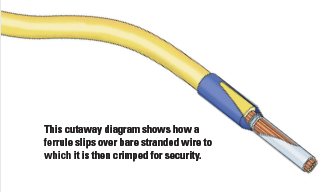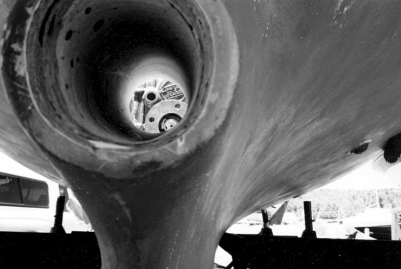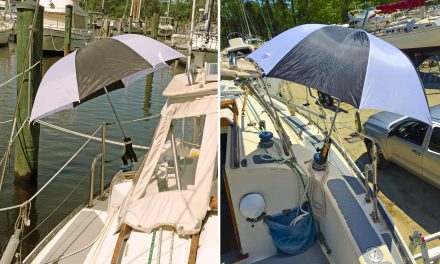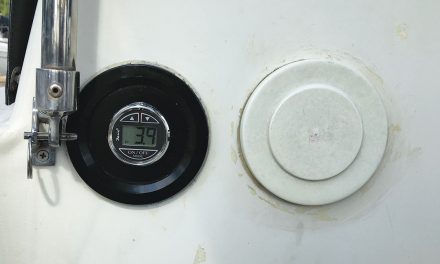They tame stranded wire and make connections secure
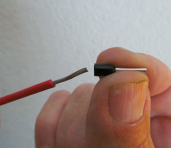
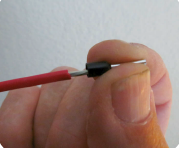
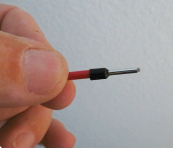
A ferrule slips easily over a stranded wire and ensures that the connection is as secure as it can be in devices that are connected with bare wire rather than crimped-on terminals
On a boat, stranded copper wires are the norm, and connections are usually made using crimped ring terminals. A lot of the electrical devices on board, however, incorporate screw-terminal blocks. On Nine of Cups, the Adler-Barbour refrigerator compressor and the 120-volt AC selector switch, as well as some of the electronics, use screw terminals. For most of the equipment intended for use on a boat, these screw terminals are designed so that it is acceptable to simply insert the stranded wire into the terminal and lock it into place with the screw. A better method is to use a ferrule.
A basic ferrule is a short tin-plated copper tube that is slipped onto the end of a stripped wire and crimped in place. The crimped ferrule holds the individual strands of wire together and forms a gas-tight seal. To make assembly easier and to increase wire durability, most ferrules also have a conical-shaped plastic collar on one end of the copper tube. Ferrules come in a host of different sizes designed to fit wires from AWG 28 to AWG 1. The plastic collars are color-coded to make it easy to identify the size of the ferrule.
Ferrules have two significant advantages over bare wire:
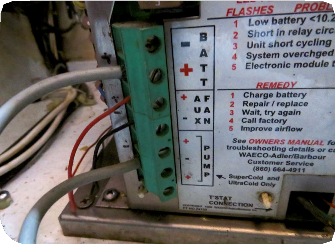
Adler-Barbour terminal block
No stray strands –I used 8 AWG wire to power my Adler- Barbour compressor, but the terminal block is located in a hard-to-see place and I found it difficult to push the stranded wire into the screw terminal without a stray strand or two of wire separating from the bundle. When pushing the entire wire bundle into the funnel shape of the ferrule collar, stray strands are easy to spot.
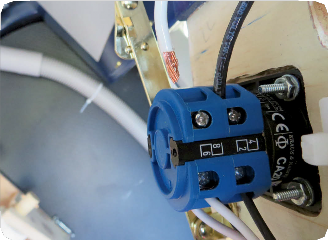
the selector switch.
Better long-term connection –Weidmuller, a company that manufactures electrical components, including ferrules, did a long-term study of wire connections using solid wire, stranded wire, and stranded wire terminated in ferrules. The study measured the electrical resistance of the connections in a standard environment as well as a salty environment over a period of years. The solid wire performed the best, showing little change in the electrical resistance of the connection over a four-year period, whereas the stranded wire showed a significant increase in the electrical resistance with time. In fact, the study showed the resistance of the stranded-wire connection reached an unsafe level in just over three years in a salty environment. The addition of ferrules to the stranded wire resulted in a connection that performed almost as well as the solid wire.
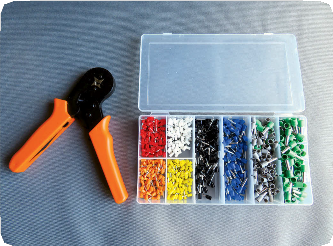
Ferrules are color-coded for size and can be purchased in a kit that includes a crimping tool.
A special tool is required to properly crimp a ferrule, but for those not expecting to crimp hundreds of connections, an inexpensive tool can be purchased online. For less than $30, I bought a kit that included a crimper and a large assortment of ferrules that will suffice for most of the electrical work on the boat.
Resources
- American Boat and Yacht Council Inc. ABYC E-11: AC and DC Electrical Systems on Boats
- Link to Weidmuller Ferrules White Paper: search with “white paper weidmuller”
- “Marine Electrical Wiring 101,” Good Old Boat, July 2014

